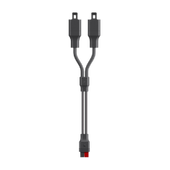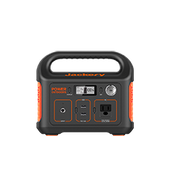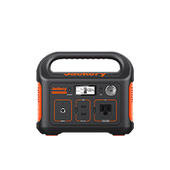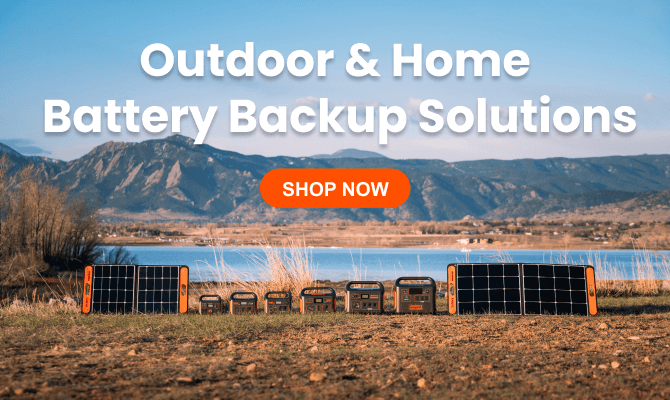When severe weather strikes or the power grid fails to handle the load, unexpected and sudden power outages occur, disrupting daily life. A portable generator powered by gas, propane, or solar can charge essential household appliances and maintain normalcy during such times. However, understanding how to use a generator during a power outage is extremely important, especially if you have a fuel-based generator.
Out of all the types, gas or propane generators need careful planning as the emission of toxic fumes can negatively impact your health. However, solar battery backups for homes, like Jackery Solar Generators, are eco-friendly and reliable charging solutions that can charge most appliances like refrigerators, TVs, lights, fans, etc, without emitting toxins. They are portable and can be moved to power devices from one room to another.
How to Use a Generator During a Power Outage: Step-by-Step Process
Severe storms can cause short or long-term power outages, and a generator can help you keep essential appliances running for hours. Here's how to use a generator during a power outage:
Step 1: Set Up Your Generator
If you have a gas or propane generator, make sure to check if it has enough oil to charge the appliances. It is always better to always use fresh fuel and avoid keeping excess fuel in the generators for more than a few months. Unplug all the loads (if already connected) before you flip the switch.
Step 2: Start Your Generator
Next, turn on the fuel valve so the fuel reaches the carburetor to start the engine. You can also turn on the choke to give a little extra fuel to the generator's engine so it can get started. The ignition switch will power the spark plug, and turning it on ensures the engine starts. Push the starter button or pull the recoil cord to get the engine going, and let it warm up before making any connections.
Step 3: Plug in Your Appliances
Plug the cords into the generator, and avoid stringing multiple extension cords together. You can either plug the appliances directly into the generator or use the extension cords connected to the generator. Avoid plugging the generator into the wall outlet, as backfeeding can potentially lead to electrocution.
Once the power is back, you should shut down the generator, unplug all the cords and appliances, and turn the fuel switch off to cool the generator down.
If you use a gas or propane generator during a power outage that emits harmful gases, follow these safety tips from the Washington State Department of Health and FEMA.
Don't Overload the Generator
The first step is to determine the amount of power needed by the appliances you are planning to charge simultaneously with the help of the generator. As a general rule, it is recommended that the generator can produce more power than that drawn by the appliances you connect to it, including the starting watts needed when they are turned on. Remember, if your appliances draw more power than your generator can handle, it can damage the appliances or blow a fuse on the generator.
Don't Use Fuel Based Generator Indoors
If you own a gas or propane generator, do not use it indoors or in an enclosed space like a garage, basement, or carport. Even if you open doors and windows, they can still lead to carbon monoxide buildup in the home.
If you feel dizzy, weak, or sick when the generator is turned on, get some fresh air right away. For additional safety, you can install battery-powered home CO (carbon monoxide) alarms to prevent toxic emission buildup.
Use Gas or Propane Generator Outdoors
Gas or propane generators that emit toxic gases or fumes should be placed away from doors, windows, and vents that might draw carbon monoxide indoors. As a general thumb rule, you should install these generators 20 feet away from the buildings.
Even if you use these generators 20 feet away, the toxic fumes can come inside through home windows, doors, or attic vents. So, make sure to have a carbon monoxide detector inside the home to avoid any mishaps.
Connect the Generator Safely
You should consider plugging appliances directly into the generator. If you want to connect the generator to the house wiring, make sure to call a qualified professional and install a power transfer switch. As a safe practice, you should never try to power the house wiring by plugging the gas generator into the wall outlet, which is known as backfeeding.
Use and Store Generator Fuel Safely
You should turn the generator off and let it cool before you start refueling. This ensures the gasoline spilled on hot engine parts doesn't ignite. Always store the generator fuel in an approved safety can outside the living area.
How to Use a Solar Generator During a Power Outage
Jackery manufactures highly efficient solar generators, portable power stations, and solar panels suitable for indoor use. Jackery Solar Generators work by combining Jackery Portable Power Stations and Jackery SolarSaga Solar Panels.
The foldable solar panels can be unfolded and placed under direct sunlight to convert solar energy into DC electricity. Then, the DC current is supplied to the portable power station's pure sine wave inverter, which produces AC electricity suitable for charging household appliances for long hours.
Since the solar generators work using safe solar energy and do not emit toxic fumes, you can use them indoors or even in enclosed spaces. Here's how to use a solar generator during a power outage:
Step 1: Place the Solar Panels Under Direct Sunlight
The first step is to unfold the Jackery SolarSaga Solar Panels and place them under direct sunlight. Make sure the solar panels are placed in such a way that the highly efficient monocrystalline silicon solar cells can absorb the maximum sunlight.

Step 2: Connect the Solar Panels With the Power Station
Next, connect the multiple solar panels with the help of solar cables. Once the solar panels are connected together, you can plug the cable into the DC input port of the Jackery Portable Power Station to start the charging process.

Step 3: Start Charging the Appliances
That's it! You can now plug the appliances you want to charge into the Jackery Portable Power Stations' output ports.

For more information, you can check out the YouTube video that depicts how to set up Jackery Solar Generator 2000 Plus.
Portable Generators for Power Outages
Jackery is a renowned solar brand that manufactures whole-home battery backups in different sizes and capacities so you can stay powered during unexpected power outages. Unlike gas or propane generators, these solar generators do not emit harmful gases or toxic fumes, making them ideal for indoor usage.
The Jackery Solar Generators emit only 30dB of noise, which is equal to a quiet library or less than the hum of a refrigerator. Even if power outages happen at night, you can rest assured that solar generators can charge most household appliances like CPAP machines or refrigerators at night — without emitting noise or gases.
Below, we will recommend the three best battery backups for home to deal with power outages and blackouts:
Jackery Solar Generator 2000 Plus Kit (4kWh)
If you live in an area that often experiences frequent and long-term power outages, you can consider the Jackery Solar Generator 2000 Plus Kit (4kWh). Its powerful battery can charge 99% of household appliances, such as refrigerators, ACs, electric stoves, microwaves, fans, and lights. With the help of the Jackery Manual Transfer Switch, you can connect the battery backup to the home's electrical system to ensure the appliances stay powered in the blink of an eye, even during power outages.
Appliances Running Time
- Refrigerator (400W) = 8.6H
- Pellet Stove (100W) = 34.7H
- CPAP Machine (40W) = 86.8H
- Electric Blanket (100W) = 34.7H
- AC (1000W) = 3.4H
- TV (150W) = 23.1H

Jackery Solar Generator 2000 Plus
The Jackery Solar Generator 2000 Plus is an expandable charging solution that can charge 99% of your household appliances for hours. Whether you want to charge a refrigerator to keep food fresh or lights to stay powered at night, the solar-powered generator has your back! It can also be connected to the home's electricity system with the manual transfer switch to ensure essential appliances like computers and the Internet keep running smoothly.
Appliances Running Time
- Refrigerator (400W) = 4.3H
- Pellet Stove (100W) = 17.3H
- CPAP Machine (40W) = 43.4H
- Electric Blanket (100W) = 17.3H
- AC (1000W) = 1.7H
- TV (150W) = 11.5H

Jackery Solar Generator 3000 Pro
The Jackery Solar Generator 3000 Pro has an efficient battery that can charge most household appliances when there is an unexpected power cut in your area. It features double wheels and a pull rod to quickly move the solar generator from one room to another to charge the appliances. The multiple output ports ensure you can charge a CPAP machine, a light, and a portable fan for the whole night.
Appliances Running Time
- Refrigerator (400W) = 6.4H
- Pellet Stove (100W) = 25.7H
- CPAP Machine (40W) = 64.2H
- Electric Blanket (100W) = 25.7H
- AC (1000W) = 2.5H
- TV (150W) = 17.1H

One of the Jackery users used Jackery Solar Generator 2000 Plus to charge their appliances during the power outage caused by Hurricane Milton. Here's what they say:
“The Jackery 2000 Plus and two additional Jackery Battery Pack 2000 Plus units definitely delivered during Hurricane Milton! I started using it on Wednesday around 7 p.m. when the power went out. I had it charged to 100%. This was my first usage, so I kept to the essentials. It was running my refrigerator, my coffee grinder, and my coffee maker. Friday morning, it was still at 50%. I am so pleased with my Jackery setup!”

FAQs
Can you use a generator during a power outage?
Yes, you can use a gas or solar generator during a power outage to keep essential appliances charged for hours. Jackery offers a wide range of solar battery chargers that ensure an uninterrupted power supply to appliances anytime, anywhere.
How long do generators last during a power outage?
How long a generator can run during a power outage or what size generator is needed for a house depends on the total wattage of the appliances you plan to charge and their running time.
For example, let's consider you are using the Jackery Solar Generator 3000 Pro to charge a refrigerator (400W), a few lights (20W), and a CPAP machine (40W). The running time can be calculated using the below formula:
Working Hours = Battery Capacity in Wh × 0.85 ÷ Operating Wattage of the Appliances = 3024Wh × 0.85 ÷ 460W = 5.5H
Note: We have multiplied by 0.85 because there will be some power loss when charging the appliances.
Can generators run overnight?
Yes, you can run a generator overnight, especially if it is solar-powered. This is because solar generators do not emit toxic fumes, which means they can charge indoor appliances safely. However, if you are using gas or propane generators, it is essential to follow the safety guidelines and ensure proper ventilation.
Conclusion
When the power goes out for an extended period, you will likely either buy a portable generator to charge the essential appliances or use the one you already have. However, incorrectly using the generator can lead to dangerous consequences such as fire, electrocution, or electric shock. That's why it's essential to understand how to use a generator during a power outage.
Following the safety guidelines mentioned in this guide will help you charge the appliances while ensuring you stay protected. If you are planning to buy a whole-home battery backup to stay charged during a power outage, you can check out the Jackery Solar Generators, which are available in different sizes. They are portable, highly efficient, and powerful enough to charge most household appliances whenever required!
Have you prepared yourself for the power outage? Drop your comments on how you are planning to stay powered!




















































































































Leave a comment